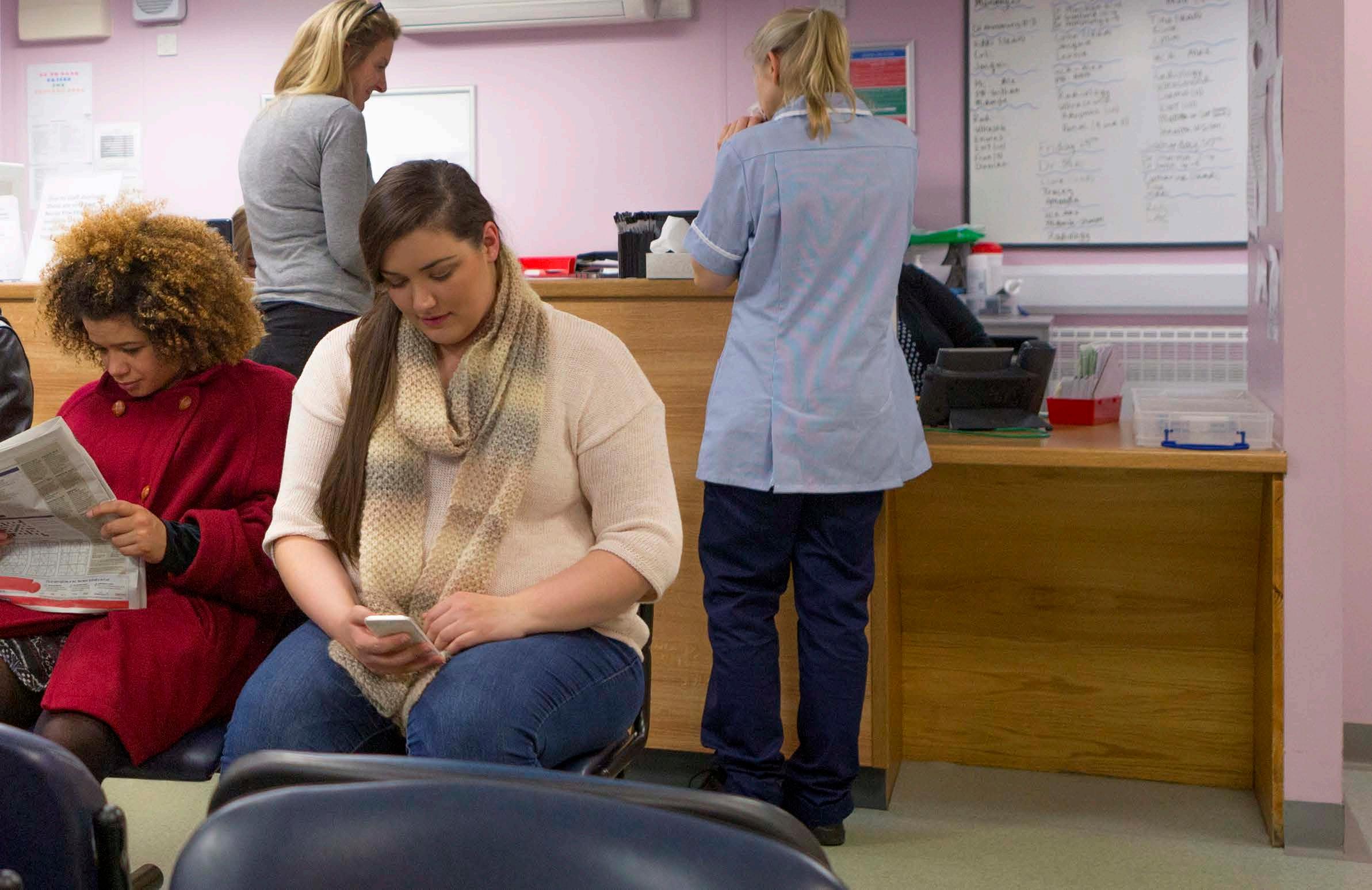
Orange County Health Improvement Plan 2020-2022 HEALTHIER Orange County’s www.ochealthiertogether.org
SUGGESTED CITATION
Orange County Health Improvement Plan 2020-22. Santa Ana, CA. January 2020. Available at: www.ochealthiertogether.org
HEALTHIER
Orange County’s Orange County’s Healthier Together is a communitywide initiative that aligns public and private resources within the public health system to improve health for all who live, work, and play in Orange County. The initiative is administered by Orange County Health Care Agency, Public Health Services.
1 BACKGROUND
Acknowledgements | Message from the Chairs | Vision and Values | Summary of Priorities
2 PRIORITY AREA PLANS
Social Determinants of Health | Access and System Navigation | Health Promotion and Community Planning | Mental Health and Substance Use | Older Adult Health | Sexual Health | Public Health System
3 PLANNING & ASSESSMENTS
Planning Framework and Timeline | Determining Priorities | Forces of Change Assessment | Community Themes and Strengths Assessment
Contents
4 COMMUNITY HEALTH INDICATORS
Selecting Indicators | Social and Demographic Profile | Social and Economic Indicators | Access to Health Services | Cancer | Diabetes, Disabilities and Heart Disease and Stroke | Exercise, Nutrition, and Weight | Injury and Accidents | Maternal, Fetal, and Infant Health and Family Planning | Mental Health and Mental Disorders | Respiratory Diseases | Substance Abuse | Summary Measures of Health | Older Adults and Aging | Oral Health
5 REFERENCE DOCUMENTS
Abbreviations and Acronyms | Citations
Orange County’s Healthier Together is a community-wide initiative that aligns public and private resources within the public health system to improve health for all communities in Orange County. This initiative is led by the Orange County’s Healthier Together Health Improvement Partnership.
HEALTH IMPROVEMENT PARTNERSHIP (HIP)
The Health Improvement Partnership guides and leads the Orange County Healthier Together assessment and planning process. Member organizations include:
• 2-1-1 Orange County
• Alzheimer’s Family Services Center
• American Heart Association
• Beacon Health Options
• Boat People SOS
• CalOptima
• Chapman University
• Children’s Bureau of Southern California
• Children’s Hospital of Orange County
• California State University at Fullerton (CSUF)
• Community Health Initiative of Orange County
• CSUF Center for Successful Aging
• First 5 Children and Families Commission of Orange County
• Health Funders Partnership
• Hoag Memorial Hospital
• Kaiser Permanente
• Latino Health Access (LHA)
• LGBT Center of Orange County
• MemorialCare Health System
• MOMS Orange County
• Multi-Ethnic Collaborative of Community Agencies (MECCA)
• Omada Health
• Orange County Asian and Pacific Islander Community Alliance (OCAPICA)
• Orange County Department of Education
• Orange County Health Care Agency
• Orange County Medical Association
• Orange County Social Services Agency
• Orange County United Way
• Orange County Women’s Health Project
• Providence St. Joseph Health
• The Cambodian Family Community Center
• University of California at Irvine (UCI) Health
• UCI Institute for Clinical and Translational Science
• UCI Program in Public Health
Acknowledgements
iv « Acknowledgements « OCHIP 2020-22
We extend special thanks to the following individuals and work groups who provided leadership and guidance in the planning process throughout 2019.
HEALTH IMPROVEMENT PARTNERSHIP CO-CHAIRS
David Souleles November ‘14 - Present Orange County Health Care Agency, Public Health Services
Vattana Peong January ‘19 - Present The Cambodian Family Community Center
HEALTH IMPROVEMENT PARTNERSHIP STEERING COMMITTEE
Cecilia Bustamante-Pixa St. Joseph Hospital
Helene Calvet Orange County Healthy Aging Intiative
Patricia Cantero Latino Health Access
Christy Cornwall Mission Hospital
Tamarra Jones Orange County Health Care Agency, Public Health Services
Dareen Khatib Orange County Department of Education
David Nuñez Orange County Health Care Agency, Public Health Services
Oladele Ogunseitan University of California at Irvine, Program in Public Health
Debbie Rose California State University at Fullerton, Center for Successful Aging
Incoming Members:
Cynthia Okialda Orange County Strategic Plan for Aging
Clayton Chau Be Well Orange County
Claudia Magee CalOptima
Allyson Sonenshine Women’s Health Project
HEALTH IMPROVEMENT PARTNERSHIP WORK GROUPS AND PLANNING PARTNERS
Social Determinants of Health - HIP Social Determinants of Health Work Group
Access and System Navigation – HIP Steering Committee, Be Well Orange County, CalOptima
Health Promotion and Disease Prevention - HIP Health Promotion and Disease Prevention Work Group
Mental Health and Substance Use – Be Well Orange County
Older Adult Health – Orange County Strategic Plan for Aging
Sexual Health – Orange County STI Coalition
OCHIP 2020-22 » Acknowledgements » v
OTHER PARTICIPATING AGENCIES
Thank you to the following organizations for your contributions through participation in assessments, focus groups, and work groups. Your input and feedback was invaluable in shaping this plan.
Altamed Health Services
America on Track
American Lung Association
Asian Americans Advancing Justice – Orange County
Be Well Orange County
Boys and Girls Club of Garden Grove
Cancer Kinship
Center for Oral Health
Children’s Bureau
Community Action Partnership of OC
Council on Aging – Southern California
Covered OC Collaborative
Early Childhood OC
Early Childhood Mental Health Collaborative
Emory University
Family Resource Centers - Gary Center, South OC
Healthy Smiles for Kids of Orange County
Help Me Grow
Hospital Association of Southern California
Kid Healthy
Laguna Hospital
Latino Health Access
Live Healthy OC
March of Dimes
Marshall B. Ketchum University
Mission Hospital
National Alliance on Mental Illness Orange County
Nu Care
OC Grantmakers
OC Mental Health Board
Orange Grants
Pathways
Regional Perinatal Program of California
Saddleback Hospital
Santa Ana Unified School District
SeniorServ
Sequoia Foundation
SJH Community Partnership Fund
Staff of Supervisor Andrew Do
St. Joseph Hospital
St. Jude Medical Center
The Coalition of Orange County Community Health
Centers
The Olin Group
UC Cooperative Extension
Vietnamese American Cancer Foundation
Western Governors University
Special thanks to the following staff of the Orange County Health Care Agency, Public Health Services for their assistance in producing this plan: Donna Fleming, DPA, MSW, Consultant; Jane Chai, MPH, Public Health Projects Manager; Genesis Sandoval, MPH, CHES, Staff Specialist; and Kristin Alix, MPH, Health Communications Specialist.
vi « Acknowledgements « OCHIP 2020-22
Message from the Chairs
On behalf of the Orange County Health Improvement Partnership (HIP), we are pleased to present the 2020-22 Orange County Health Improvement Plan. This plan was informed by a year-long community health assessment that found that while Orange County’s health, as a whole, continues to fare well compared to other areas, there are some troubling trends and disparities that impact our communities.
The HIP identified that improving health in Orange County requires a close look at the conditions that create health inequities. To that end, two of the six focus areas in this plan address overall system issues: Social Determinants of Health and Access and System Navigation. The remaining four areas highlight health topics identified as the most pressing to work on in the next three years: Health Promotion and Disease Prevention; Mental Health and Substance Use; Older Adult Health; and Sexual Health.
We are pleased to welcome Be Well OC, CalOptima, OC Strategic Plan on Aging, and OC STI Coalition and thank our HIP Steering Committee, Social Determinants of Health Work Group, and Health Promotion and Disease Prevention Work Group for leading work in their respective focus areas. The goals, objectives, and strategies outlined in the plan reflect their hard work and commitment to improving health in Orange County.
We want to especially thank the residents and community partners who contributed their time and ideas in developing this plan. By working together, we know we can achieve our vision that “Orange County is a community where everyone has opportunities and resources to be healthy and enjoy safety and optimal quality of life.”
Sincerely,
HIP Co-Chairs
Vattana Peong, MPH Executive Director The Cambodian Family Community Center
 David Souleles, MPH Deputy Agency Director Orange County Health Care Agency Public Health Services
David Souleles, MPH Deputy Agency Director Orange County Health Care Agency Public Health Services

OCHIP 2020-22 » Message from the Chairs » 1
Vision for a Healthy Orange County VISION
Orange County is a community where everyone has opportunities and resources to be healthy and enjoy safety and optimal quality of life.
V ISION FOR A SYSTEM THAT WILL SUPPORT A HEALTHY ORANGE COUNTY
The public health system is a partnership promoting a healthy Orange County that includes residents, health care providers, community and faith-based organizations, schools, businesses, government entities, and others. Our vision of Orange County’s public health system is driven by our shared values and strives to be:
• responsive , accessible , and accountable to the communities it serves
• well-connected and coordinated across various sectors
• driven by data and committed to quality through learning, innovation, and use of best practices
• positioned to anticipate and respond to current and future challenges and opportunities impacting health
2 « Vision and Values « OCHIP 2020-22
VALUES
Our vision for a healthy Orange County is driven by the following common values:
Inclusivity and Diversity
Healthy communities and systems value and respect the needs, perspectives, and contributions of all people.
Equity
Eliminating disparities and attaining optimal health for all is best achieved by addressing root causes of inequalities.
Comprehensive
Health includes physical, mental, and emotional well-being and is impacted by many factors (but not limited to) economics, environments, education, and social conditions.
Collaborative
Optimal health requires cross-sectorial partnerships between many entities including (but not limited to) residents, health providers, community-based organizations, faithbased organizations, schools, businesses, and government.
Multi-dimensional
Health must be understood at the individual, family, and neighborhood level.
Prevention and Health Promotion
Optimal health starts with the prevention of disease and injury at its root cause, including the creation and sustenance of health promoting and protective environments; and is supported by prevention initiatives, early intervention services, and access to high quality care and treatment.
Self Sufficiency and Autonomy
Health and overall wellbeing includes self-sufficiency, the ability to advocate for one’s self and others, and functional independence for those with disabilities and illness.
OCHIP 2020-22 » Vision and Values » 3
2020 - 22 Orange County Health Improvement Plan Summary of Priority Areas
SYSTEM TOPICS
ACCESS AND SYSTEM NAVIGATION
The HIP will work with CalOptima and Be Well OC to meet our ideals of a public health system that is:
• responsive, accessible, and accountable to the communities it serves;
• well connected and coordinated across various sectors.
SOCIAL DETERMINANTS OF HEALTH
Goal: Achieve health equity by addressing the root causes that impact health outcomes across Orange County.
4 « Summary of Priorities « OCHIP 2020-22
HEALTH TOPICS
HEALTH PROMOTION AND DISEASE PREVENTION
Goal 1: Increase the proportion of community members who are in a healthy weight category.
Goal 2: Reverse the trend of increasing rates of diabetes.
MENTAL AND SUBSTANCE USE
Goal: Orange County will lead the nation in optimal mental health and wellness for all residents.
OLDER ADULT HEALTH
Goal: Orange County is a place that creatively nurtures, encourages, and supports the growing numbers of older residents.
SEXUAL HEALTH
Goal 1: Reduce sexually transmitted infection (STI) rates in Orange County.
Goal 2: Reduce teen birth rates in Orange County.
OCHIP 2020-22 » Summary of Priorities » 5
Priority Area Plans
Social Determinants of Health
Our health is influenced by social factors such as where we are born, what our family’s income is, what education we get and jobs we have, how much support we get from family and friends, and what stigma we face in the community. Therefore, improving health for all must address factors influencing health at the community level including income, education, transportation, social environment, and public safety. 1,2
Social determinants of health was identified as a new area of interest in the 2017-2019 Orange County Health Improvement Plan. As a result, the Health Improvement Partnership (HIP) formed a Social Determinants of Health Work Group to explore work in this area. The work group conducted a survey with Orange County’s Healthier Together stakeholders that revealed that the vast majority of partners are doing some work on key social determinants of health issues including economic stability, educational attainment, healthy social and community contexts, health care access, and neighborhood and built environment. However, barriers such
as resource limitations, lack of political will, and low awareness about the topic, stifle work in the area and will need to be addressed.
In recent years, interest in work to address social determinants of health has increased with CalOptima and nonprofit hospitals funding efforts to address economic insecurity and housing. In addition, collaboratives such as Be Well Orange County and the Orange County Strategic Plan for Aging have prioritized social determinants such as housing and transportation in their work.

8 « Social De terminants of Health « OCHIP 2020-22
QUICK FACTS
į Asian or Pacific Islander baby girls can expect to live almost 10 years longer than African American baby boys. 3
į Economically disadvantaged 5th graders are three times more likely to be obese than others. a
į Residents with lower education levels are more likely to report poorer health status, higher rates of disability, and higher rates of serious psychological distress. 4

Babies born just miles apart in Orange County face up to a 7-year difference in life expectancy. ³
Learn more at: www.ochealthiertogether.org/ socialdeterminants
OCHIP 2020-22 » Social Determinants of Health » 9
Social Determinants of Health

Goals, Objectives, and Strategies
HIP Planning Partner: Social Determinants of Health Work Group
The OC Health Improvement Partnership’s Social Determinant of Health Work Group currently guides efforts in this area. The work group is led by representatives from the American Heart Association/American Stroke Association, Mission Hospital, and Orange County Department of Education with participation from Chapman University, Children’s Hospital of Orange County, Institute of Healthcare Advancement, Orange County Health Care Agency, St. Joseph Health, UC Cooperative Extension, and UCI.
Goal Achieve
10 « Social Determinants of Health « OCHIP 2020-22
health equity by addressing the root causes that impact health outcomes across Orange County.
Objective 1: By December 2022, increase the engagement of diverse sectors to ide ntify and support opportunities that address the root causes of health.
Measures:
• Increase new partners from diverse community sectors engaged in social determinants of health work.
• Increase the number of Orange County Health Improvement Partnership members who participate in cross sector discussions and partnerships.
• Increase the number of partners who can identify at least one social determinants focus in their work.
Strategies:
• Create common language that can be used to discuss social determinants of health.
• Convene a network of partners from
diverse sectors to work collaboratively to address social determinants of health.
• Create a health equity pledge that can be used by various sectors to serve as a commitment to address social determinants of health.

Objective 2: By December 2022, increase the capacity of cross sector community pa rtners to address health equity through their work.
*This objective will be further developed after initiation of Objective 1.
OCHIP 2020-22 » Social Determinants of Health » 11
Access and System Navigation
Access to health care impacts an individual’s overall health including prevention of disease and detection and treatment of health conditions.
1 In addition to having health insurance, access to health care must consider cost of care, ability to navigate the system, and cultural and linguistic competency of providers.

Orange County’s health care system includes more than 37 medical hospitals, two behavioral health hospitals, 210 home health and hospice agencies, 76 long-term care facilities, and 65 community clinics. 2 Orange County has no public hospital and safety net services are provided by a combination of public and private entities including private physicians, hospitals, urgent care centers, and emergency departments. Orange County’s 37 hospitals have about 8,000 beds and 27 emergency departments. 2 There are 26 community clinic organizations with over 76 sites in Orange County that serve about 340,000 residents annually. 3 , 4 Behavioral health services are provided through a collaboration of public and private partnerships largely led by Orange County Health Care Agency, Behavioral Health Services and are described in more detail in the Mental Health and Substance Use section of this plan.
Health care services are paid for through a mix of commercial health insurance, public funds, private funding, and self-pay. 5 In Orange County, Medi-Cal is managed through CalOptima, a County-organized health system that provides publicly-funded health care coverage for low-income children, adults, seniors and people with disabilities in Orange County. CalOptima’s programs include Medi-Cal, OneCare Connect Cal MediConnect Plan (Medicare-Medicaid Plan), OneCare (HMO SNP), and the Program of All-Inclusive Care for the Elderly (PACE) and cover almost 25% of county residents. 6 In 2018, CalOptima conducted a comprehensive Member Health Needs Assessment that helped to inform care delivery and improve access to care. In 2018, Be Well Orange County emerged as an initiative to bring together public and private partners to create a coordinated system of mental health care in Orange County.
12 « Access and System Navigation « OCHIP 2020-22
QUICK FACTS
į Almost 1 in 7 Orange County adults over 19 years of age do not have health insurance a
į Almost 1 in 10 people in Orange County reported delays or difficulty getting medical care they felt they needed b
į More than 1 in 3 Orange County adults who indicated needing behavioral health care services did not receive them c Learn more at: www.ochealthiertogether.org/access

OCHIP 2020-22 » Access and System Navigation » 13
Almost people in Orange County report not having a usual place to go when they are sick.d
1 in 6
Access and System Navigation Partner Priorities
Health Improvement Partnership (HIP)

The HIP’s vision for the public health system is one that is responsive, accessible, and accountable to the communities it serves and well connected and coordinated across various sectors. The HIP is working with CalOptima and Be Well Orange County as planning partners in improving access and system navigation.
As described in the Public Health System section of this plan , the HIP has developed next steps for improving the public health system based on its ideals for the system. The HIP identified seven next steps in improving the public health system, including one that focuses on access and system navigation:
• Expand inventory of services and resources and work to develop workforce capacity and improve coordination and integration of services will be next step for improving the public health system.
These next steps are key priorities for action for the HIP and its Steering Committee.
CalOptima
CalOptima is the sole Medi-Cal plan in Orange County, serving approximately 740,000 members (at time of printing) through its Medi-Cal, OneCare Connect, OneCare, and PACE programs. 6 CalOptima is an important part of the health care sector and is in a unique position to impact and address access and system navigation in Orange County, particularly for lowincome individuals who qualify for services. CalOptima’s 2020-22 Strategic Plan includes key priorities to improve access and system navigation.
CalOptima’s 2020-22 Strategic Plan includes five priority areas. Highlighted objectives that align with the HIP’s goal to improve access and system navigation are shown here.
Innovate and Be Proactive
• Leverage new federal and state programs and services to improve access and quality of care for members
• Seek opportunities to further integrate care for members
Expand CalOptima’s Member-Centric Focus
• Focus on population health
14 « Access and System Navigation « OCHIP 2020-22
3. Close Treatment Gaps and Improve Access: All Orange County residents can access needed programs and services when and where they need them
Be Well Orange County
• Strengthen provider network and access to care
Performance indicators:
• Enhance member experience and customer service
3a. Mental health equity and disparities
3b. Expand utilization of peer services and grow provider pool
Strengthen Community Partnerships
• Increase collaboration with providers and community stakeholders to improve care
3c. Optimal interorganizational care pathways and warm connections
• Utilize strong advisory committee participation to inform community engagement strategies
Launched in 2018, Be Well OC is an initiative that brings together public, private, academic, and faith-based organizations to create a coordinated system of mental health care and support, including substance use services, for all Orange County residents.
Access and system navigation is a cross cutting initiative of the six result areas identified by Be Well Orange County.
Result 1. Reduce Mental Health Stigma
Increase Value and Improve Care Delivery
4. Strengthen Crisis Reponses: All Orange County residents can access crisis support through a network of facilities mobile teams, and digital tools
• Evaluate and implement value-based purchasing strategies that drive quality
Performance indicators:
• Deploy innovative delivery models that address social determinants of health and homelessness
4a. Incidence of mental health crises and suicides (attempts, completions)
4b. Appropriate utilization of CSUs and ED and inpatient services
• Maintain focus on providing high-quality care provided to members
4c. Utilization of mobile support services and navigation app
Enhance Operational Excellence and Efficiency
• Invest in infrastructure and efficient processes
5. Establish Community Wellness Hubs: Coordinated, integrated, response health, behavioral health and wellness services capacity. Integrated primary care/ behavioral health, urgent needs, mobile

• Engage workforce and identify development opportunities
More information at www.caloptima.org .
Result 2. Prevent and Act Early
Result 3. Close Treatment Gaps and Improve Access
Result 4. Strengthen Crisis Responses
Result 5. Establish Community Wellness Hubs
Result 6 . Align Partners, Policies, and Programs
More information at www.bewelloc.org
OCHIP 2020-22 » Access and System Navigation » 15
Health Promotion and Disease Prevention
Chronic diseases such as heart disease, cancer, and stroke account for 7 in 10 deaths in Orange County. 1 Prevention and management of conditions such as obesity, diabetes, and high blood pressure are key to decreasing illness and death due to these conditions.
Orange County has many programs working to prevent chronic diseases by promoting and supporting healthy behaviors and access to preventative services. Women, Infants, and Children (WIC) offers education and food assistance for low-income residents to purchase healthy food. CalFresh Healthy Living provides nutrition education in school and community settings.
Orange County is also rich in collaboratives working on prevention of obesity and other chronic diseases. The Nutrition and Physical Activity Collaborative (NuPAC) brings together partners to facilitate networking and collaboration in the areas of nutrition and physical activity. Collaboratives have formed to coordinate and network around policies and programs that improve health. The Health Improvement Partnership’s Obesity Work Group formed in 2014 and
helped to coordinate these efforts using a collective impact approach. The Orange County Diabetes Collaborative has worked to coordinate these efforts and increase screening and chronic disease management activities in Orange County.
Health care providers, hospitals, and community based organizations offer chronic disease screening, prevention, and management programs throughout the county. Environmental approaches are used by some programs to create communitylevel changes in the built environment or to increase access to healthy choices. An example is the OC Health Care Agency’s Healthy Neighborhoods Program, which partners with jurisdictions to create environments that are walkable and include options for healthy eating.

16 « Health Promotion and Disease Prevention « OCHIP 2020-22
QUICK FACTS
į 1 in 5 adults in Orange County is obese. a
į More than 1 in 4 Orange County adults have high blood pressure.
b
į Rates of diabetes have increased by 45% in Orange County in the last ten years. c

į In 2018-2019, 53.4% of economically disadvantaged 5th graders in Orange County were in the healthy weight category.²
Learn more at: www.ochealthiertogether.org/ healthpromotion
OCHIP 2020-22 » Health Promotion and Disease Prevention » 17
¹
deaths in Orange County are caused by chronic diseases such as heart disease, cancer, and stroke.
7 in 10
Health Promotion and Disease Prevention
Goals, Objectives, and Strategies
HIP Planning Partner:
HIP Health Promotion and Disease Prevention Work Group
The OC Health Improvement Partnership’s Health Promotion and Disease Prevention Work Group guides efforts in this area. The work group reorganized in 2019 and is composed of members from the former OC HIP Obesity Work Group and the OC Diabetes Collaborative, which each previously addressed the Obesity and Diabetes priority area of previous Orange County Health Improvement Plans. Current members include community partners representing America on Track, American Diabetes Association, California State University at Fullerton, CalOptima, Community Action Partnership of Orange County, Dairy Council of California, First 5 Orange County, Kid Healthy, MOMS Orange County, Orange County Department of Education, Orange County Health Care Agency, PHFE Women, Infants, and Children Program (WIC), Providence St. Joseph, Southland Integrated Services, and University of California Cooperative Extension.
Goal 1
Increase the proportion of community members who are in a healthy weight category.
Objective 1: By December 2022, increase by 1% the proportion of economically disadva ntaged children and adolescents who are in the healthy weight category.
Objective 2: By December 2022, increase by 0.5% the proportion of economically disadva ntaged children and adolescents who are in the healthy weight category in Anaheim, Buena Park, La Habra, and Santa Ana.

Countywide Strategies:
• Coordinate consistent messages about obesity with health care providers.
• Provide resident leadership academy training.
• Provide capacity support to coalitions throughout Orange County.
18 « Health Promotion and Disease Prevention « OCHIP 2020-22
Targeted Strategies for Anaheim, Buena Park, La Habra, and Santa Ana:
Support community-specific coalitions in implementing collective impact approaches including multi-sector interventions specified such as the following:
• Support implementation of school wellness plans.
• Collaborate with partners to assess Early Childhood Education sites that implement nutrition and physical activity standards and follow-up with technical assistance.

• Promote and expand community efforts involving parents and families.
• Identify ways to engage WIC participants up to five to improve a “healthy start” for nutrition.
• Build the capacity of residents to work with school districts, schools, Parent Teacher Student Associations and educators to expand Policy, system, and environmental changes.
Goal 2 Reverse the trend of
Objective 1: By December 2022, hold the Type 2 Diabetes prevalence under c urrent statewide rates of increase to 9.0%.
Strategies:
• Promote and expand availability and utilization of effective diabetes prevention and self-management programs by persons who are at risk for diabetes and living with pre-diabetes, diabetes, or gestational diabetes.
• Improve coordination of and communication about diabetes screening, diabetes prevention, and self-management education efforts to ensure that programs are accessible to all populations, with special emphasis on those at greatest risk.
OCHIP 2020-22 » Health Promotion and Disease Prevention » 19
increasing rates of diabetes.
Mental Health and Substance Use

Nearly 1 in 6 people in Orange County report needing help with mental, emotional, or substance abuse problems. d Mental health is essential to a person’s emotional, social, and psychological well-being, and can have a serious impact on physical health. Mental health disorders and chronic substance use are associated with increased risk of diseases and health conditions including diabetes, hypertension, stroke, heart disease, and cancer and unintended injuries. 1, 2
Orange County’s mental health system, including services addressing substance use, is largely led by the Orange County Health Care Agency, Behavioral Health Services (BHS). Through public and private partnerships including CalOptima, hospital systems, and private and community providers, BHS works to coordinate prevention and treatment services across the lifespan and improve the quality of and access to services. Additionally, the Orange County Mental Health Board is advisory to the Orange County Board of Supervisors and is the official community body that advocates for an accessible, appropriate, and effective mental health system. Orange County is also a recipient of Mental Health Services Act (MHSA) funds, which help to
fund a full continuum of mental health and supportive services to address serious mental illness, as well as prevention efforts. Components of the system include community services and supports, workforce education and training, prevention and early intervention, housing, capital facilities and technology, and innovation. The Orange County Health Care Agency’s Prevention and Intervention Team works with a range of community partners to address underage drinking, prescription drug misuse, and driving under the influence of alcohol or drugs. In 2018, Be Well Orange County emerged as an initiative to bring together public and private partners to create a coordinated system of mental health care in Orange County.
20 « Mental Health and Substance Use « OCHIP 2020-22
QUICK FACTS
į More than 1 in 3 Orange County adults who indicate needing behavioral health care services did not receive them. a

į There has been an increase in suicide rates in Orange County in the past 10 years. b
į Orange County has higher hospitalization rates due to alcohol or substance use compared to 75% of California counties. e,f
Learn more at: www.ochealthiertogether.org/ mentalhealth
OCHIP 2020-22 » Mental Health and Substance Use » 21
Nearly people in Orange County report needing help with mental, emotional, or substance abuse problems. d
1 in 6
Mental Health and Substance Use

Goals, Objectives, and Strategies
HIP Planning Partner: Be Well Orange County
The OC Health Improvement Plan supports and aligns with goals, objectives, and strategies identified by Be Well Orange County ( www.bewelloc.org ). Launched in 2018, Be Well OC is an initiative that brings together public, private, academic, and faithbased organizations to create a coordinated system of mental health care and support, including substance use services, for all Orange County residents.
Be Well OC has identified six results and associated performance indicators to improve mental health and substance use in Orange County. These will be tracked as part of the Orange County Health Improvement Plan in support of the mental health and substance use focus area. At the time of publishing, Be Well OC partners are actively working on defining indicators to track and measure progress. Objectives and strategies for Be Well OC will be updated as part of the Be Well OC’s regular planning process and will be updated on www.ochealthiertogether. org and www.bewelloc.org .
Goal
Orange County will lead the nation in optimal mental health and wellness for all residents.
1. Reduce Stigma: Improved mental health awareness attitudes, and understanding throughout the Orange County community.
Performance indicators:
1a. Public awareness and changed conversation
1b. Ability to recognize disorders
1c. Knowledge of professional help and treatment availability
1d. Knowledge of effective self-help strategies
2. Prevent and Act Early: Effective prevention and early intervention services are available to all Orange County residents.
Performance indicators:
2a. Investments in prevention and early intervention
2b. Expand Social-Emotional Learning in early childhood education/care settings
2c. Outreach, engagement by peers and early diagnosis
22 « Mental Health and Substance Use « OCHIP 2020-22
3. Close Treatment Gaps and Improve Access: All Orange County residents can access needed programs and services when and where they need them.
Performance indicators:
3a. Mental health equity and disparities
3b. Expand utilization of peer services and grow provider pool
3c. Optimal interorganizational care pathways and warm connections

4. Strengthen Crisis Responses: All Orange County residents can access crisis support through a network of facilities, mobile teams, and digital tools.
Performance indicators:
4a. Incidence of mental health crises and suicides (attempts, completions)
4b. Appropriate utilization of CSUs and ED and inpatient services
4c. Utilization of mobile support services and navigation app
5. Establish Community Wellness Hubs: Coordinated, integrated, response health, behavioral health and wellness services capacity. Integrated primary care/ behavioral health, urgent needs, mobile
treatment strategically located in three geographic regional areas.
Performance indicators:
5a. Inter-agency and interorganizational collaboration
5b. Implement core Hub services, and region-specific services
5c. Broad array of services (e.g. crisis, wellness, mobile health, in-home support, peer run education)
6. Align Partners, Policies, and Programs: Addressing complex, interrelated issues of mental illness, addiction, and homelessness, among others.
Performance indicators:
6a. Homeless System of Care
6b. ACEs and Trauma informed care
6c. Cross-sector partnerships
6d. University-Behavioral Health program partnerships
OCHIP 2020-22 » Mental Health and Substance Use » 23
Older Adult Health
There are over 470,000 Orange County residents 65 years old or older. That number is expected to double by the year 2040, when one in four residents will be 65 or older. 1 As older adults are faced with various health, economic, and social concerns, it is critical for the public health to be prepared to meet the needs of our aging population.
Orange County benefits from numerous programs and agencies that serve the needs of older adults, including the Office on Aging, Council on Aging-Southern California, other governmental agencies, health care systems, academic institutions with special research/focus on older adults and numerous community-based organizations. The Office on Aging is the lead advocate, systems planner, and facilitator relative to all aging issues, and oversees the Senior Citizen Advisory Council (SCAC), manages an information/assistance line for seniors, provides outreach and services, and coordinates state-required planning efforts. Council on Aging-Southern California oversees the Ombudsman Program, the ReConnect EIOSA program, a financial abuse team, a health insurance counseling program, and a friendly visitor program for seniors. Numerous entities and programs, from cities to small nonprofits to
large countywide programs, serve specific needs of seniors, such as nutritional assistance, adult day health care, chronic disease self-management classes, and programs to promote health and socialization in seniors.
Older adults in Orange County enjoy a high level of health insurance coverage (almost 99%) and many resources exist to assist seniors with their health care and social needs. The Orange County Aging Services Collaborative (OCASC) brings together many of the larger partners in senior services to increase awareness and coordinate services for this growing population. In 2016, OCASC brought together community partners in order to create the first Orange County Strategic Plan for Aging (OCSPA). OCSPA has identified key initiatives to improve the lives of older adults in Orange County.

24 « Older Adult Health « OCHIP 2020-22
QUICK FACTS
į More than 1 in 4 older adults have heart disease. a

į 1 in 4 older adults have diabetes. b
į More than 1 in 10 older adults were treated for Alzheimer’s disease or dementia. c
į Large proportions of older adults, 42.5% of single elders and 19.8% of elder couples, cannot afford basic costs for housing, health care, food, and transportation. d,e
Learn more at: www.ochealthiertogether.org/ olderadulthealth
2x
OCHIP 2020-22 » Older Adult Health » 25
The older adult population is expected to double by 2040 , when one in four Orange County residents will be 65 or older. f
Older Adult Health

Goals, Objectives, and Strategies
HIP Planning Partner:
OC Strategic Plan for Aging
The OC Health Improvement Plan supports and aligns with goals, objectives, and strategies identified in the Orange County Strategic Plan for Aging ( www.ocagingplan. org ). OCSPA is a countywide initiative created by Orange County’s community leaders including Alzheimer’s Orange County, Meals on Wheels Orange County, CalOptima, Orange County Health Care Agency, Orange County Community Foundation and others to develop short and long term strategic plans for Orange County’s growing older adult population.
OCSPA has identified 10 key initiatives to improve the lives of older adults in Orange County. Two initiatives will be tracked as part of the Orange County Health Improvement Plan including: Health Care and Senior Nutrition and Food Security. Objectives and strategies for the Strategic Plan for Aging at time of publishing the 2020-2022 OC Health Improvement Plan are set for June 2020 and will be updated as part of the OCSPA’s regular planning process.
26 « Older Adult Health « OCHIP 2020-22
Goal Orange County is a place that creatively nurtures, encourages, and supports the growing number of older residents.
Health Care
Objective 1: By June 2020, promote evidencebased health promotion programs with at least 700 older adults who complete the workshops.
Objective 2: By June 2020, create outreach strategy and promote physical activity recommendations for older adults.

Objective 3: Increase utilization of the Annual Wellness Visit by 1% per year.
Strategies:
• Support the promotion and marketing outreach efforts of evidence-based health promotion programs to community providers.
• Identify existing at-home exercise guides for older adults and highlight on IrisOC, a local digital hub to distribute healthy aging information and provide connections to senior-focused community resources and individuals.
• Identify and support activities led by Council on Aging Southern California to promote the Annual Wellness Visit toolkit.
Nutrition and Food Security
Objective 1: By June 2020, increase food security for Orange County’s older adults a ge 60+.
Strategies:
• Coordinate efforts to increase enrollment in CalFresh, the federal nutrition program to help eligible, low-income individuals purchase food they need for good health.
• Increase participation in Restaurant Meal Program (RMP), which allows elderly, disabled, and homeless CalFresh recipients and their spouse to use Golden state Advantage (EBT) card to purchase prepared meals from participating restaurants.
• Increase awareness of overall food help for older adults and the www.ocfoodhelp. org website as a resource for food help information.
OCHIP 2020-22 » Older Adult Health » 27
Sexual Health
Sexual health is an important part of overall health and includes avoiding sexually transmitted infections (STIs) and unplanned pregnancies. 1 Syphilis, gonorrhea and chlamydia cases are at the highest levels in 30 years and continue to increase. 2 Disparities in teen pregnancy and STIs also have significant implications for certain communities in Orange County.3

Orange County’s STI and family planning services are offered through Orange County Health Care Agency, private providers, and community-based clinics and programs. Orange County Health Care Agency, Communicable Disease Control Division and HIV Surveillance monitor trends in STIs and HIV and help Public Health Investigators link individuals to care.
County and community-based family planning service providers offer initiation and management of all FDA-approved methods of contraception, STI and HIV testing and treatment, and individual reproductive health education and counseling for clients. STI/HIV testing sites are concentrated in central Orange County, with sites in the high risk and high population cities of Santa Ana, Anaheim, and Garden Grove. Over 40 medical providers in Orange County prescribe pre and postexposure prophylaxis (PrEP and PEP). The OC Health Care Agency offers partner services, which helps inform partners of potential exposure to HIV or syphilis. The OC Health
Care Agency’s HIV Planning and Coordination unit administers funding for HIV prevention, testing, care, and support services through County and community providers. Support services includes case management services, which help to remove barriers to health care and connect persons living with HIV/AIDS to community resources.
The California Healthy Youth Act requires public school districts to provide comprehensive sexual health education to all students in grades 7 through 12, at least once in middle school and again in high school. 6 However, few school districts comply with the legal mandate. Health education is offered through communitybased organizations, colleges and universities. The OC Health Care Agency has a health educator who provides community and provider education and training. In 2019, the OC Health Care Agency launched STI testing and HIV anti-stigma media campaigns in English, Spanish, and Vietnamese to cities with the highest rates of STIs and HIV.
28 « Sexual Health « OCHIP 2020-22
QUICK FACTS
į At 120.7 per 100,000 Orange County’s 2018 gonorrhea incidence rate is more than three time higher than it was in 2010.ª
į Comparing 2010 to 2018, the chlamydia case rate increased from 281.5 per 100,000 to 443.8 per 100,000. b
į Each year, about 300 people are newly diagnosed with HIV disease in Orange County. 4

į Teen birth rates in Santa Ana, La Habra, Anaheim, and Buena Park are higher than the state average. 5
Learn more at: www.ochealthiertogether.org/ sexualhealth
At 13.8 per 100,000, Orange County’s 2018 primary and secondary syphilis rate is almost six times higher than it was in 2010. c 6x
OCHIP 2020-22 » Sexual Health » 29
Sexual Health
Goals, Objectives, and Strategies
HIP Planning Partner: Orange County STI Coalition
The OC Health Improvement Plan (HIP) planning partner for the Sexual Health priority area is the Orange County Sexually Transmitted Infection Coalition (OC STIC). OC STIC’s mission is to decrease STIs in Orange County through community education and advocacy. OC STIC members include government programs, key community stakeholders, health care providers, community-based organizations, and educators.
Goal 1
Reduce STI rates in Orange County.
Objective 1: By December 2022, stabilize the early syphilis disease case rate in Orange County to at or below 23.9 per 100,000 people.
Objective 2: By December 2022, train at least 150 providers on the STI and HIV Standards of Care.
Strategies:
• Establish a Sexual Health work group to coordinate, share data and engage in community advocacy
• Adopt an STI and HIV Standards of Care curriculum

• Coordinate outreach and provision of STI and HIV Standards of Care community provider training
• Increase social media engagement within priority cities and sub-populations
30 « Sexual Health « OCHIP 2020-22
Goal 2
Reduce Teen birth rates in Orange County.
Objective 1: By December 2022, reduce birth rate per 1,000 females, 15 to 19 y ears of age, by 10% in cities that exceed the Orange County teen birth rate.
Strategies:
• Offer schools and school districts technical assistance with the California Healthy Youth Act (CHYA), starting in cities with a teen birth rate that exceeds the Orange County teen birth rate

• Provide education to schools and providers regarding minors’ rights and barriers to access
• Promote sexual and reproductive health (SRH) core competencies in primary care
• Provide SRH education to at risk youth outside of school setting
• Provide SRH education to parents and adults who work with youth
• Increase social media engagement within priority cities and sub-populations
OCHIP 2020-22 » Sexual Health » 31
Public Health System
Improving the health of the community requires a well-coordinated and functioning public health system that supports efforts to provide high-quality programs and services. As depicted in the illustration below, Orange County’s

public health system is a partnership promoting a healthy Orange County that includes residents, health care providers, community and faith-based organizations, schools, business, government entities and others.
In April and May 2019, the Health Improvement Partnership (HIP) conducted the Orange County Public Health System Assessment , which included an online survey and an in-person discussion to determine strengths, weaknesses, and opportunities to improve Orange County’s public health system. A full summary of the Orange County Public Health System Assessment including specific feedback and discussion of strengths, weaknesses, and opportunities for improvement is available on the Orange County’s Healthier Together Community Health Assessment page at: www.ochealthiertogether.org/CHA2019
32 « Public Health System « OCHIP 2020-22 Public Health Schools Transit Public Safety Correc ons Research Hospitals Elected Officials Businesses Behavioral Health Civic Groups Parks & Rec Health Care Providers Community Based Orgs Residents Social Services City Planners Faith-Based Ins tu ons Health Collabora ves
Next Steps
Based on findings from the Public Health System Assessment, the Health Improvement Partnership is working on the following next steps to improve Orange County’s public health system.
5
1
Engage community partners and stakeholders in sectors such as public safety, parks and recreation, transportation, and business to identify and support opportunities to promote health and other mutually beneficial goals that address social determinants of health.
5 2
5 3
45
Expand inventory of services and resources and work to develop workforce capacity and improve coordination and integration of services across Orange County.
55
65
Disseminate community health data and the Orange County Health Improvement Plan to stakeholders, staff, and funders through communications and marketing that leverage www.ochealthiertogether. org as a resource.
75
Engage funders to ensure buy-in and funding of identified needs and priorities and use the Orange County Health Improvement Plan to drive and leverage funding.
Coordinate access to data and encourage use of consistent definitions, timeframes, and sources for measurement and planning through use of data and resources on www.ochealthiertogether.org
Promote access to and sharing of aggregate health data from health providers and health plans to better inform planning efforts.
Ensure that social determinants of health, such as poverty, education, and social environment, are represented and emphasized as contributors to health in data and best practices.
OCHIP 2020-22 » Public Health System » 33
Planning and Assessments
Planning Framework and Timeline
The Orange County Health Improvement Partnership (HIP) began assessment and planning for the 2020-2022 Orange County Health Improvement Plan at the beginning of 2019. The plan is the foundation of Orange County’s Healthier Together initiative and seeks to align efforts by the various parts of the public health system to improve health for all communities in Orange County.
The HIP utilized Mobilizing for Action through Planning and Partnerships (MAPP) as its framework for this planning process. MAPP was developed by the National Association of City and County
Health Officials (NACCHO) and the Centers for Disease Control and Prevention (CDC) as a tool to bring together stakeholders to identify community health issues and take action. Key phases of MAPP include 1) organizing and partnership development; 2) visioning; 3) conducting assessments; 4) identifying strategic issues; 5) formulating goals and strategies; and 6) acting. A distinctive feature of MAPP is the use of four coordinated assessments, each of which yields important information and, when taken as a whole, provides a comprehensive understanding of a community’s health.
The following is a summary of each assessment:
Forces of Change
Conduct stakeholder group discussions to determine:
• What is occurring or might occur that affects the health of our community?
• What are specific threats or opportuni es generated by these occurrences?
Community Health Status
Review key health indicators with Health Improvement Partnership to determine:
• What does the health status of Orange County look like?
• How healthy are our residents?
Consider community focus groups to determine:
• What are our priori es for health?
• What is working well in how we address health?
• What are areas for improvement?
Conduct assessment with key stakeholders to determine:
• How responsive, accessible, and accountable is our system?
• How well connected and coordinated is our system?
• How data-driven and focused on best prac ces and quality is our system?
• How well posi oned to an cipate and respond to health impacts is our system?
OC Public Health System Community Themes and Strengths
36 « Planning Framework and Timeline « OCHIP 2020-22
The table below shows the HIP’s timeline for the completion of this plan. As shown, assessments were conducted and findings were reviewed in a series of meetings to guide the HIP in determining goals, objectives, and strategies to be published in its final plan.
Determine planning process and choose community health indicators
A rm foundation principles
Forces of Change Assessment
OC Public Health System Assessment
Community Themes and Strengths Assessments
Community Health Status Assessment
Identify preliminary priority areas
Share ndings of community health assessments
Determine goals, objectives, and strategies
Approve work plans and next steps
Disseminate Plan for public comment
Finalize and publish OC Health Improvement Plan
Summaries of community health assessments are available on Orange County’s Healthier Together Community Health Assessment page at www.ochealthiertogether. org/CHA2019.
OCHIP 2020-22 » Planning Framework and Timeline » 37
2019
APR - MAY MAR MAR JUN JUL JUL MAR-SEP JAN 2020 DEC NOV SEP - NOV
JAN-FEB Y 0
Criteria for Selection of Priorities
At its meeting on March 20, 2019, the Health Improvement Partnership reviewed and proposed revisions to criteria for selection of priorities. The Health Improvement Partnership reviewed and affirmed the following revised criteria at is meeting on May 2, 2019.
The following were the criteria for selection of priority issues:
1. Health Impact: To what degree would action on this health issue improve overall health in Orange County?
2. Disparity: To what degree does addressing this health issue reduce health disparities within the county?
3. Trends: To what degree does addressing this health issue assist Orange County in intervening with a health indicator that is trending negatively or progressing too slowly?
4. Root Cause: To what degree does the health issue have a root cause that is modifiable at the individual, community, institutional level?
5. Efficiency: To what degree can action on this health issue address multiple issues?
6. Economic Impact: To what degree would addressing this health issue decrease economic impact downstream?
7. Prevention: To what degree does the health issue benefit from primary prevention?
8. Early Intervention: To what degree does the health issue benefit from early intervention?
9. Collaboration: To what degree would collaborative or multisector approaches to address this health issue improve chances for success?
10.Under-addressed Issue: To what degree is this health issue not addressed or is under-addressed in Orange County?
38 « Determining Priorities « OCHIP 2020-22
Determining Priority Areas
On July 17, 2019, the Health Improvement Partnership (HIP) hosted a one-day meeting with about 70 people representing more than 40 agencies including hospitals, nonprofit agencies, universities, community health centers, and others. The meeting was Orange County’s community health assessment using the MAPP framework Handouts summarizing the Forces of Change and Orange County Public Health System Assessment were provided before the meeting and referred to during the day. During the day, subject-matter experts then gave presentations as part of the Community Health Status Assessment , discussing trends and populations at risk for over 50 key health indicators for Orange County. A summary of indicators presented as part of the Community Health Status Assessment are available in the Summary of Health Indicators section. The most current indicators are available on the www. OCHealthierTogether.org/CHADashboard


As part of the Community Themes and Strengths Assessment , a panel presented findings from recent community needs assessments including CalOptima’s 2018 Member Health Needs Assessment, Kaiser Permanente and UCI Health’s community health needs assessments, and HIP focus groups.
At the end of the day, the HIP reviewed their criteria for selection of priorities and went through a Consensus Workshop process to determine priority areas to include in the 2020-22 Orange County Health Improvement Plan. The following is a summary of the priority topics:
1. Social Determinants of Health
2. Access and System Navigation
3. Mental Health and Substance Use
4. Sexual Health
5. Older Adults
6. Chronic Disease Prevention and Management and Health Promotion (working name)
After the meeting, HIP Steering Committee
members and work group leads began working on identifying partners that would lead and establish a plan for each area. As the HIP’s approach is to align with and uplift e xisting work, partners for each focus area were selected because they were already conducting significant work in the focus area consistent with the HIP’s identified values as a HIP work group or existing community collaborative.
Presentations for the day are posted on the July 17, 2019 Meeting page
OCHIP 2020-22 » Determining Priorities » 39
Forces of Change Assessment
On March 20, 2019, members of Orange County’s public health system participated in an assessment (Forces of Change Assessment) to identify trends, events, or factors (forces) that affect the community’s health. Fortyfive stakeholders representing 26 agencies including Orange County Health Care Agency, community-based health and social service providers, health care providers, academic institutions,
ECONOMIC FORCES
1. Affordable Housing
THREATS
į increased disease transmission from crowding
į increased stressors
į impediments to children’s development and education
collaboratives, and others participated in this assessment.
The assessment included a discussion of forces specific to the social, economic, technological and political environment in which we live and work. The following is a summary of key forces that were identified during the meeting along with threats and opportunities associated with each.
OPPORTUNITIES
į new models of housing being developed
į increased public awareness of the crisis and need for solutions
2. Economic Disparity
THREATS
į inability to access nutritious foods, safe and adequate housing, health care
į may increase violence/crimes
į increased stressors
OPPORTUNITIES
į public assistance programs including Cal Fresh
į potential new models for funding education and work force development
40 « Forces of Change Assessment « OCHIP 2020-22
3. Health Care Costs
THREATS
į businesses leaving
į people choosing high deductibles/copays and not accessing care
OPPORTUNITIES
į new models of care
į increased focus on prevention
4. Health Care Financing Structures
THREATS
į inadequate number of providers accepting insurance
į preferential treatment based on personal resources
į systems still incentivizing illness/disease treatment rather than prevention
5. Food Industry
THREATS
į consumption of inexpensive, high-calorie, nutrient-poor foods leading to obesity and nutrition-related diseases such as diabetes
į food waste associated with mass production of foods
OPPORTUNITIES
į new models
OPPORTUNITIES
į increased public awareness about nutrition
į initiatives on locally grown foods
į corporations could produce healthier options for large markets
Additional Topics Discussed
į Climate change: long-term significant impacts to health, economics
į Automation: elimination of many jobs and inadequate opportunities for other training
į Aging population: inadequate economic base to support aging population
į Public Health funding: decreases to funding are reducing prevention efforts
OCHIP 2020-22 » Forces of Change Assessment » 41
TECHNOLOGICAL FORCES
THREATS
į more information sharing decreases individual privacy and may decrease trust
į less personal care
į more provider time may be spent on documentation
OPPORTUNITIES
į more information and consultation available for care
į greater access in rural areas
į improved continuity of care and less duplication and cost
THREATS
į loss of privacy
į a feeling of less personal care
į dependent upon patient health literacy and ability to use systems and information
į uncertainty/unreliability of web-based information; information overload
THREATS
į decreases in physical activity leading to weight gain, disease, pain and injury
į jobs are being displaced by automation
į potentially less direct social interaction
4. Personal Devices and Applications
THREATS
į addiction to tech
į decreased socialization and activity
į risk of misinformation
į bullying
į dependence on literacy
OPPORTUNITIES
į more reliable information
į quicker feedback loop on health status
į patient empowerment
į reinforces prevention
OPPORTUNITIES
į safer driverless cars
į increased self-sufficiency for people with disabilities
į lower cost of products
į safer work environments
OPPORTUNITIES
į decreased isolation
į access to information including health promotion/education
į emergency notifications
42 « Forces of Change Assessment « OCHIP 2020-22
1. New Provider Technologies
2. New Patient Technologies
3. Automation
Additional Topics Discussed
į Automated statewide welfare system: increased consistency and accessibility across the state
į Telecommuting: increased isolation and tension between office-based and telecommuting employees, more flexibility for worker, reduced carbon foot print
POLITICAL FORCES
1. Immigration
THREATS
į immigrants fearful of accessing needed services resulting in exacerbation of health issues and potential spread of disease
į stressors have increased, potential for violence against immigrants has increased, and separation of families has impacted mental health and economic stability
2. Health for All
THREATS
į structural changes could decrease access (if costs shift to individuals), decrease quality (by limiting services), and lead to provider shortages
OPPORTUNITIES
į grassroots efforts and advocacy may strengthen communities
OPPORTUNITIES
į discussions may lead to new models that increase access and/or control costs.
3. Federal Administration
THREATS
į reduced access to service, particularly prevention services, may result in poor health outcomes, increases in unplanned pregnancies (particularly teen), etc.
OPPORTUNITIES
į increased community engagement and advocacy
OCHIP 2020-22 » Forces of Change Assessment » 43
4. State Administration
THREATS
į there likely will be diversion of funds from existing programs, new taxes and/ or diversion of county funds to fund state initiatives
OPPORTUNITIES
į new policies should increase support for early childhood education, universal health care, affordable housing, family leave, etc.
Additional Topics Discussed
į Land use: vacant lots in Santa Ana, gentrification of neighborhoods and displacement of residents and businesses
į The Orange County political landscape: shift from right to center
į Fragmentation between state and counties in California: lack of accountability, inconsistencies, and lack of parity between counties
į Mental Health Services Act funding in Orange County
SOCIAL FORCES
1. Social Media and Globalization of Information
THREATS
į social media and the increased commercial use of the Internet have resulted in a decrease in privacy, parental involvement and family cohesion
į new opportunities for exploitation and the propagation of misinformation including public health information
2. Immigration
THREATS
į policy changes and increased fear have resulted in separation of families, immigrants not accessing critical services and health care, and increased vulnerability of immigrants to exploitation and violence
OPPORTUNITIES
į there is increased access to information, and, for many, increased connectivity and sense of community, particularly for those who are physically isolated
OPPORTUNITIES
į none identified
44 « Forces of Change Assessment « OCHIP 2020-22
3. Sense of Community and Cultural Assimilation
THREATS
į increased assimilation may result in a decrease in parental involvement and cohesion (particularly considering language barriers), a loss of cultural identity and a decrease in cultural competency in the larger community
Additional Topics Discussed
OPPORTUNITIES
į more opportunities within (and among) communities for community building, addressing issues through collective impact, teaching social diversity, and having multiple social movements work together
į Discrimination: stigma, fear, hate crimes, bullying, racism, sexism and discrimination against LGBTQIA continues; shifts in societal views and increased acceptance of differences
į Mental health: increase in youth suicide, general isolation, and reported mental health issues; an increase in public awareness and understanding of mental health
į Changes in the drug culture: increase in vaping, marijuana and prescription drug use; tobacco use has declined
į Aging of the population: 25% of the county’s population will be over 65 years old, many are living alone
į Family dynamics: millennials are staying in parent’s homes longer; parenting trends appear to emphasize social and emotional development, positive discipline, and building resiliency
į Weakening of legal social protections: laws and policies are less likely to protect consumers, the environment, civil rights, reproductive rights, etc., than in recent years
į Incarceration: too much money in incarceration vs. treatment, job training, education, other interventions
į Education attainment: disparities in the educational system, policy and funding threats to public school investments; emphasis on testing
OCHIP 2020-22 » Forces of Change Assessment » 45
Community Themes and Strengths
The Community Themes and Strengths Assessment is used to gather input from community members about what they think is important and the strengths and challenges regarding health. As part of this assessment, the Health Improvement Partnership (HIP) considered findings from focus groups conducted by Orange County Health Care Agency on behalf of the HIP as well as the most recent community health needs assessments conducted by partners including CalOptima, Kaiser Permanente, and UCI Health. Findings were presented as part of a panel presentation at the HIP’s meeting on July 17, 2019. All presentations from the day are available at www.ochealthiertogether.org/cha2019
OC HEALTH IMPROVEMENT PARTNERSHIP FOCUS GROUPS
In June 2019, Orange County Health Care Agency staff conducted six focus groups throughout Orange County to ask community members about what they thought was important to health. Below is a summary of the location and makeup of the focus groups:
• Westminster – Vietnamese older adults
• Santa Ana – Spanish-speaking adults
• Buena Park – Spanish-speaking moms
• Orange – Adolescents
• La Habra – Service providers
• Lake Forest – Services providers
Focus group questions:
1. When you think about [community*] health, what is one thing that comes to mind?
2. What makes you optimistic or hopeful about [community*] health? What is working well?
3. What most concerns you?
4. What are the most important priorities for [community*] health?
5. What is most important for us to consider as we create this plan to improve [community*] health in Orange County ?
* “Community” was used in some focus groups, then later removed from the question to determine if the term was skewing responses.
46 « Community Themes and Strengths Assessment « OCHIP 2020-22
The following were themes discussed by focus groups:
Vietnamese Older Adults
į Clean water
į Navigation of health services
į Access to mental health services
į Homelessness
Adolescents
į Mental health
į Access to healthy food
į Addiction to drugs, nicotine, caffeine among youth
į Environment
Spanish-language Groups
į Housing costs
į Homelessness and its impact on community space
į Safe and clean environments
Service Providers
į Mental health
į Housing
į Nutrition
į Early childhood development
į Health care gaps and access including to substance use treatment
į Growing aging population
OCHIP 2020-22 » Community Themes and Strengths Assessment » 47
Community Partner Assessments
As part of its Community Themes and Strengths Assessment , the HIP also considered findings from needs assessment recently conducted by community partners.
CalOptima Member Health Needs Assessment

In 2018, CalOptima, Orange County’s provider for Medi-Cal and Medicare services, conducted a comprehensive Member Health Needs Assessment (MHNA) that included 31 focus groups with 353 members, 534 telephone interviews, 6,000 paper surveys, and 250 online surveys. Notable survey findings are shown below:
• Barriers to Care: Members encountered structural and personal barriers to care. Over half (52%) didn’t think it was necessary to see a doctor for a checkup and over a fourth (28%) reported that it took too long to get an appointment.
• Lack of Awareness: There was lack of understanding about available benefits and services.
• Social and Environmental Impacts: Surveys revealed significant social and environmental difficulties such as members needing assistance with food, basic necessities, transportation, and other public assistance.
Kaiser Permanente Community Health Needs Assessment

In 2019, Kaiser Permanente conducted its Community Health Needs Assessment (CHNA) for its Anaheim and Irvine service areas, covering communities throughout Orange County. After review of secondary data and primary data through key informant interviews, focus groups, and surveys, Kaiser Permanente identified the following prioritized health needs:
• Access to Care: Barriers included difficulty navigating resources, social isolation, cost, long wait times, language barriers, lack of insurance, and immigrant status.
• Economic, Housing and Food Insecurity: Barriers to accessing affordable housing and food insecurity were noted as drivers of poor health.
• Barriers to Accessing Mental and Behavioral Health: Barriers included cost of care and insurance, lack of integration with primary care, difficulty navigating the system, language and immigration status, provider shortages, and stigma.
48 « Community Themes and Strengths Assessment « OCHIP 2020-22
• Suicide: Orange County’s rise in suicide was noted as a need with shortage of beds, Health Insurance Portability and Accountability ACT (HIPAA) and Family Educational Rights and Privacy Act (FERPA), stigma and misinformation, and lack of primary care identified as barriers to prevention and early intervention.
UCI Health
UCI Health’s CHNA was conducted for its service area, which comprises all of Orange County. The CHNA included review of secondary data and stakeholder interviews and identified the following priority health needs: 1.
Of these, UCI Health included the following in its 2020-22 Implementation Strategy: Access to health care and preventive healthcare; Cancer; Mental health; and Overweight and obesity.

Substance
and
Mental health
Housing and
Access to health care
Overweight and obesity
Preventive practices
Senior health
Cancer
Alzheimer’s disease
Stroke
use
misuse 2.
3.
homelessness 4.
5.
6.
7.
8.
9.
10.
OCHIP 2020-22 » Community Themes and Strengths Assessment » 49
Community Health Indicators
Selecting Indicators
In addition to three other assessments using the Mobilizing for Action through Planning and Partnerships (MAPP) framework, the Health Improvement Partnership (HIP) conducted the Community Health Status Assessment in July 2019. The assessment involves review of key indicators to show how Orange County is doing compared to other areas and to understand trends and disparities in health. This provides a general picture of health and answers the questions “What does overall health in Orange County look like?” and “How healthy are our residents?”
To identify the indicators to review as part of Orange County’s Community Health Status Assessment for the 2020-22 OC Health Improvement Plan, an ad-hoc planning group of the Health Improvement Partnership reviewed more than 300 indicators on the OC Dashboard in early 2019. The following indicators were recommended based on 1) alignment with the criteria for core indicator selection; 2) alignment with local, state, and national reports (e.g., Healthy People 2020, Healthy Places Index, OC Community Indicators, Conditions of Children); and 3) alignment with nonprofit hospital community health needs assessments. All indicators are available on the Community Health Assessment Dashboard at www.OCHealthierTogether.org/chadashboard

52 « Selecting Indicators « OCHIP 2020-22
Social and Demographic Profile
Demographics: Orange County’s population has grown by 43% in the past 30 years and has become increasingly diverse. Today, no single racial/ethnic group comprises a majority of the population; the county’s population is 40% White, 35% Hispanic or Latino, 20% Asian, and less than 2% Black or African American. Almost half (46%) of the population age 5 and over speak a language other than English at home, with 26% speaking Spanish and 15% speaking an Asian or Pacific Islander language. There has also been a rise in immigration; in 20132017 30% of residents were born outside of the US compared to 24% in 1990. Racial/ ethnic composition can look quite different across Orange County. For instance, ZIP code 92704 in Santa Ana is 73% Hispanic while ZIP code 92683 in Westminster is majority Asian (51%), and ZIP code 92672 in San Clemente is 73% White, non-Hispanic.
Orange County is experiencing changes in demographics based on age and generational experiences. “Millenials” (those age 2338 in 2019) are a growing segment of the population and make up one-fifth of the county’s population. Orange County’s older adults are the only age group that is projected to increase as a proportion of the population in the next 25 years. The number of older adults living in Orange County is expected to nearly double by the year 2040 when almost one in four residents will be 65 or older. 1

Socioeconomic Climate: Concerns about the community’s health are impacted by the high cost of living in Orange County and increasing unease about poverty and economic inequality. Based on the Family Needs Calculator, a family of four with two working adults and two school-age children would need to earn $76,488 to meet their basic needs including housing, child care, food, and medical expenses. 2 The median household income in the county was $81,851 in 2013-2017, which is higher than most US counties. However, there are large economic disparities within the county; while 17% of households earn at least $200,000 annually, 27% had an annual income of less than $50,000. While the median household income in ZIP code 92701 in Santa Ana was $46,709, almost half of the county median, the median for ZIP code 92679 in Rancho Santa Margarita was more than twice the county median at $177,197.
Driving the high cost of living in the county is housing costs. In 2013-2017, more than half (58%) of renters spent 30% or more of their household income on rent; this puts Orange County in the lowest quartile of all US counties. In 2019, the Point in Time Count identified 6,860 individuals who experienced homelessness, representing a 43% increase or more than 2,000 individuals compared to the 2017 count. 3 More than one in four Orange County households experience severe housing problems, which may include overcrowding.
OCHIP 2020-22 » Social and Demographic Profile » 53
Social and Economic Indicators

MEDIAN HOUSEHOLD
PEOPLE LIVING BELOW POVERTY LEVEL
CHILDREN LIVING BELOW POVERTY LEVEL
PEOPLE 65+ LIVING BELOW POVERTY LEVEL
HIGH SCHOOL GRADUATION
OCHIP 2020-22 » Community Health Indicators » 55
(2013-2017) CA Counties CA Value ($67,169) US Value ($57,169) Trend VALUE COMPARED TO 12.1% (2013-2017) CA Counties CA Value (15.1%) US Value (14.6%) Trend VALUE COMPARED TO 16.4% (2013-2017) CA Counties CA Value (20.8%) US Value (20.3%) Trend VALUE COMPARED TO 9.0% (2013-2017) CA Counties CA Value (10.2%) US Value (9.3%) Trend VALUE COMPARED TO 88.8% (2013-2017) CA Counties CA Value (82.7%) US Value (84.1% in 20152016) Trend VALUE
$81,851
COMPARED TO
Access to Health Services

ADULTS WITH
(5-YEAR): 19+
PEOPLE WITH A USUAL SOURCE OF HEALTH CARE
PEOPLE DELAYED OR HAD DIFFICULTY OBTAINING CARE
OCHIP 2020-22 » Community Health Indicators » 57
HEALTH INSURANCE
WITH HEALTH INSURANCE 85.4% (2012-2016) CA Counties CA Value (85.2%) US Value (85.2%) VALUE COMPARED TO 96.7% (2017) CA Counties CA Value (96.9%) VALUE COMPARED TO 84.7% (2016-2017) CA Counties CA Value (86.2%) Trend VALUE COMPARED TO 9.6% (2016-2017) CA Counties (2015-2016) CA Value (10.1%) Trend VALUE COMPARED TO US Value (95.0%)
CHILDREN

Cancer
AGE-ADJUSTED DEATH RATE DUE TO BREAST
AGE-ADJUSTED DEATH
DUE TO COLORECTAL
OCHIP 2020-22 » Community Health Indicators » 59
SCREENING: 40+
MAMMOGRAM
RATE
CANCER COLON CANCER SCREENING LUNG AND BRONCHUS CANCER INCIDENCE RATE 18.2 Deaths per 100,000 females (2015-2017) CA Counties CA Value (18.9) US Value (20.9 in 20112015) Trend VALUE COMPARED TO 76.6% (2016) CA Value (76.4%) Trend VALUE COMPARED TO 10.8 Deaths per 100,000 population (2015-2017) CA Counties CA Value (12.5) US Value (14.5 in 20112015) Trend VALUE COMPARED TO 73.6% (2009) CA Counties CA Value (68.1%) Trend VALUE COMPARED TO 40.1 Cases per 100,000 population (2011-2015) CA Counties CA Value (43.3) US Value (60.2) Trend VALUE COMPARED TO
CANCER
Diabetes, Disabilities, and Heart Disease

and Stroke
ADULTS WITH DISABILITY
AGE-ADJUSTED DEATH RATE DUE TO CORONARY HEART DISEASE
AGE-ADJUSTED DEATH RATE DUE TO CEREBROVASCULAR DISEASE (STROKE)
HIGH BLOOD PRESSURE PREVALENCE
OCHIP 2020-22 » Community Health Indicators » 61 8.4% (2016-2017) CA Counties CA Value (9.9%) US Value (10.5% in 2017) Trend VALUE COMPARED TO
DIABETES 28.5% (2017) CA Counties CA Value (29.0%) US Value (32.3%) Trend VALUE COMPARED TO 77.2 Deaths per 100,000 population (2015-2017) CA Counties CA Value (87.4) US Value (94.8) Trend VALUE COMPARED TO 35.9 Deaths per 100,000 population (2015-2017) CA Counties CA Value (36.3) US Value (37.5) Trend VALUE COMPARED TO 24.0% (2016) CA Value (29.7%) US Value (20.6% in 2015) Trend VALUE COMPARED TO 2.1 Hospitalizations per 10,000 population 18+ years (2015-2017) CA Counties CA Value (2.5) VALUE COMPARED TO AGE-ADJUSTED HOSPITALIZATION RATE DUE
UNCONTROLLED DIABETES
ADULTS WITH
TO
Excercise, Nutrition, and Weight

ADULTS WHO ARE OBESE
ADULTS WHO ARE OVERWEIGHT OR
5th GRADE STUDENTS WHO ARE OBESE
9th GRADE STUDENTS WHO ARE OBESE
TEENS
OCHIP 2020-22 » Community Health Indicators » 63
OBESE
WHO ENGAGE IN REGULAR PHYSICAL ACTIVITY 20.1% (2017) CA Counties CA Value (26.4%) US Value (31.3%) Trend VALUE COMPARED TO 53.6% (2017) CA Counties CA Value (60.4%) US Value (65.2% in 2016) Trend VALUE COMPARED TO 18.4% (2017-2018) CA Counties CA Value (21.3%) Trend VALUE COMPARED TO 14.2% (2017-2018) CA Counties CA Value (18.4%) Trend VALUE COMPARED TO 80.0% (2013-2014) CA Counties (2011-2012) CA Value (69.6%)
VALUE COMPARED TO
Injury and Accidents

SUBSTANTIATED
ELDER ABUSE IN LONG TERM CARE FACILITIES
OCHIP 2020-22 » Community Health Indicators » 65
CHILD ABUSE RATE
ABUSE
Cases per 1,000 children (2017) CA Counties CA Value (7.5) US Value (9.1 in 2016)
COMPARED TO
(2017) Trend
TO
Trend
TO Trend
ELDER
6.4
VALUE
4,263 Unduplicated confirmed cases
VALUE COMPARED
203 Substantiated complaints (2017)
VALUE COMPARED
Maternal, Fetal, and Infant
Health and Family Planning

MOTHERS WHO RECEIVED EARLY PRENATAL CARE
INFANT MORTALITY RATE
1.5 Deaths per 1,000 live births (2016)
BABIES WITH LOW BIRTH WEIGHT
(2016) CA Value (6.8%)
INFANTS EXCLUSIVELY BREASTFED
TEEN BIRTH RATE: 15-19
VALUE COMPARED TO
CA Value (15.7)
OCHIP 2020-22 » Community Health Indicators » 67
Trend
CA
Trend
6.3%
Trend
Trend
84.4% (2016) CA Value (84.6% in 2015) Trend
VALUE COMPARED
TO
Value (4.2)
VALUE COMPARED TO
VALUE COMPARED TO 29.2% (2013-2015) CA Value (29.1%)
VALUE COMPARED TO 10.9 Live births per 1,000 females aged 15-19 (2017)
Mental Health and Mental Disorders

ADULTS NEEDING HELP WITH MENTAL, EMOTIONAL, OR SUBSTANCE ABUSE PROBLEMS
ADULTS WITH LIKELY SERIOUS PSYCHOLOGICAL DISTRESS
AGE-ADJUSTED DEATH RATE DUE TO SUICIDE
OCHIP 2020-22 » Community Health Indicators » 69
NEEDING AND RECEIVING BEHAVIORAL HEALTH CARE SERVICES 15.9% (2016-2017) CA Counties CA Value (17.5%) Trend VALUE COMPARED TO 65.4% (2016-2017) CA Counties CA Value (60.9%) Trend VALUE COMPARED TO 7.9% (2015-2017) CA Counties CA Value (8.9%) Trend VALUE COMPARED TO 9.3 Deaths per 100,000 population (2015-2017) CA Counties CA Value (10.4) US Value (13.6) VALUE COMPARED TO Trend
ADULTS
Respiratory Diseases

AGE-ADJUSTED HOSPITALIZATION RATE DUE TO PEDIATRIC ASTHMA
AGE-ADJUSTED ER RATE DUE TO PEDIATRIC ASTHMA
AGE-ADJUSTED HOSPITALIZATION RATE DUE TO ADULT
AGE-ADJUSTED ER RATE DUE TO ADULT ASTHMA
OCHIP 2020-22 » Community Health Indicators » 71
6.6 Hospitalizations per 10,000 population under 18 years (2015-2017) CA Counties CA Value (8.2) VALUE COMPARED TO 27.9 ER Visits per 10,000 population under 18 years (2015-2017) CA Counties CA Value (40.5) VALUE COMPARED TO 2.8 Hospitalizations per 10,000 population 18+ years (2015-2017) CA Counties CA Value (3.8) VALUE COMPARED TO 11.7 ER Visits per 10,000 population 18+ years (2015-2017) CA Counties CA Value (19.7) VALUE COMPARED TO
ASTHMA
Substance Abuse

ADULTS WHO SMOKE
VALUE COMPARED TO
10.3% (2016-2017) CA Counties Trend
11th GRADERS WHO SMOKE
VALUE COMPARED TO
2.0% (2017-2018) CA Counties (2011-2013)
CA Value (4.3% in 2015-2017)
11th GRADERS WHO USE E-CIGARETTES
VALUE COMPARED TO
13.0% (2017-2018)
CA Value (10.0 in 2015-2017)
ADULTS WHO BINGE DRINK BY YEAR
VALUE COMPARED TO
35.5% (2015)
CA Counties (2011-2013)
CA Value (34.7%)
11th GRADERS WHO USE ALCOHOL
VALUE COMPARED TO
14.0% (2017-2018)
CA Counties (2011-2013)
CA Value (22.5% in 2015-2017)
11th GRADERS WHO USE ALCOHOL OR DRUGS
VALUE COMPARED TO
19.0% (2017-2018)
CA Value ( 29.4% in 2015-2017)
11th GRADERS WHO USE MARIJUANA
VALUE COMPARED TO
12.0% (2017-2018)
CA Counties (2011-2013)
CA Value (16.7% in 2015-2017)
OCHIP 2020-22 » Community Health Indicators » 73
Value
CA Value (11.0%) US
(17.1% in 2017)
Trend
Trend
Trend
Trend
Immunizations and Infectious Diseases

KINDERGARTNERS WITH REQUIRED IMMUNIZATIONS
OCHIP 2020-22 » Community Health Indicators » 75 CHLAMYDIA INCIDENCE RATE GONORRHEA INCIDENCE RATE HIV INCIDENCE RATE SYPHILIS INCIDENCE RATE 95.7% (2017) CA Counties CA Value (95.1%) Trend VALUE COMPARED TO 443.8 Cases per 100,000 population (2018) CA Counties CA Value (583.0) US Value (498.2 in 2015-2017) Trend VALUE COMPARED TO 120.7 Cases per 100,000 population (2018) CA Counties CA Value (199.4) US Value (146.3 in 2015-2017) Trend
COMPARED
9.5 Cases per 100,000 population (2016-2018) CA Value (12.9
20122014) Trend
COMPARED
23.9 Cases per 100,000 population (2018) CA Counties CA Value (19.1) US Value (8.5 in 20152017) Trend
VALUE
TO
in
VALUE
TO
VALUE COMPARED TO
Summary Measures of Health
Older Adults and Aging


Oral Health

OCHIP 2020-22 » Community Health Indicators » 77
DEATH RATE
ALZHEIMER’S DISEASE CHILDREN WHO VISITED A DENTIST DENTIST RATE 78.7% (2013-2014) CA Value (78.7%) VALUE COMPARED TO 37.6 Deaths per 100,000 population (2015-2017) Trend VALUE COMPARED TO 110 Dentists per 100,000 population (2017) CA Counties CA Value (83) US Value (68) Trend VALUE COMPARED TO LIFE EXPECTANCY 82.0 Years (2013) US Value (78.8) Trend VALUE COMPARED TO
AGE-ADJUSTED
DUE TO
Reference Documents
Where possible, acronyms and abbreviations are defined on each page of this report where they appear. Due to space limitations, the following acronyms and abbreviations may not have been defined on the page of the report where they appear.
• ACEs – Adverse Childhood Experiences
• AIDS – Acquired Immunodeficiency Syndrome
• BHS – Behavioral Health Services
• CDC – Centers for Disease Control and Prevention
• CDSMP – Chronic Disease Self-Management Program
• CHNA – Community Health Needs Assessment
• CHYA – California Healthy Youth Act
• CSU – Crisis Stabilization Unit
• EBT – Electronic Benefit Transfer
• ED – Emergency Department
• ER – Emergency Room
• FDA – Food and Drug Administration
• FERPA – Family Educational Rights and Privacy Act
• HIP – Health Improvement Partnership
• HIV – Human Immunodeficiency Virus
• HIPAA – Health Insurance and Portability and Accountability Act
• LGBT – Lesbian, Gay, Bisexual, Transgender
• LGBTQIA – Lesbian, Gay, Bisexual, Transgender, Queer, Intersex, Asexual
• MAPP – Mobilization for Action through Planning and Partnership
• MHNA – Member Health Needs Assessment
• MHSA – Mental Health Services Act
• NACCHO – National Association of City and County Health Officials
• NuPAC – Nutrition and Physical Activity Collaborative
• OC – Orange County
• OCASC – Orange County Aging Services Collaborative
• OCSPA – Orange County Strategic Plan for Aging
• OCTEC – Orange County Education and Education Coalition
• PEP – Post-Exposure Prophylaxis
• PHFE – Public Health Foundation Enterprises
• PrEP – Pre-Exposure Prophylaxis
• RMP – Restaurant Meal Program
• SCAC – Senior Citizen Advisory Council
• SRH – Sexual and Reproductive Health
• STDs – Sexually Transmitted Diseases
• STIs – Sexually Transmitted Infections
• UCI – University of California, Irvine
• UCLA – University of California, Los Angeles
• US – United States
• WIC – Women, Infants, and Children
Abbreviations and Acronynms
80 « Abbreviations and Acronyms « OCHIP 2020-22
SOCIAL DETERMINANTS OF HEALTH
1. Healthy People 2020 [Internet]. Social Determinants of Health Overview. [cited 2019 10/2/19]; Available from: https://www.healthypeople. gov/2020/topics-objectives/topic/social-determinants-of-health .
2. Public Policy Frameworks for Improving Population Health. 2006. 896(1): p. 281-293.
3. Orange County Health Care Agency, Life Expectancy in Orange County. 2015: Santa Ana, CA.
4. Bostean, G. Social Determinants of Health Outcomes in Orange County, CA. Orange County Health Improvement Partnership meeting 2019; Available from: http://www.ochealthiertogether.org/content/sites/ochca/ HIP_Agenda_and_Highlights/2019-07-17_HIP_Meeting/04_SDOH_in_OC_ Bostean_recd_2019-07-11.pdf .
OC Dashboard ( www.ochealthiertogether.org/communitydashboard )
a. 5th Grade Students who are Obese : California Department of Education (2017-2018)
ACCESS AND SYSTEM NAVIGATION Citations
1. Institute of Medicine (US) Committee on Monitoring Access to Personal Health Care Services, Access to Health Care in America, ed. M. Millman. 1993, Washington, DC: National Academies Press.
2. California healthcare facilities licensed by California Department of Public Health, Licensing and Certification (last updated Dec. 2, 2019). Office of Statewide Health Planning and Development (OSPHD)
3. Locations of Community Health Centers, Orange County, CA, prepared by Health Policy Research and Communication, March 2019.
4. Coalition of Orange County Community Health Centers Strategic Plan 2017-2020 http://www.coccc.org/about-us/strategic-plan
5. Vishaal Pegany and Lucien Wulsin. Delivery Systems and Financing Care for the Remaining Uninsured in Orange County Composite Summary and Recommended Options for Discussion 2015; Available from: www.itup.org .
6. CalOptima Fast Facts: December 2019. https://www.caloptima.org/~/ media/Files/CalOptimaOrg/508/NewsandPublications/2019/2019-12_ FastFacts_508v2.ashx
OC Dashboard ( www.ochealthiertogether.org/communitydashboard )
a. Adults with Health Insurance (5-year) : 19+: American Community Survey, 2013-2017
b. Adults Delayed or had Difficulty Obtaining Care : CHIS, 2016-2017
c. Adults Needing and Receiving Behavioral Health Care Services : CHIS, 2016-2017
d. People with a Usual Source of Health Care : CHIS, 2016-2017
OCHIP 2020-22 » Citations » 81
HEALTH PROMOTION AND DISEASE PREVENTION
1. Orange County Health Care Agency, Premature Mortality in Orange County. 2014: Santa Ana.
2. California Department of Education. 2018-19 California Physical Fitness Report. Available from: https://data1.cde.ca.gov/dataquest/PhysFitness/PFTDN/ Summary2011.aspx?r=11&t=3&y=2018-19&c=30000000000000&n=0000
OC Dashboard ( www.ochealthiertogether.org/communitydashboard )
a. Adults Who Are Obese : California Health Interview Survey (2017)
b. Adults with Diabetes : California Health Interview Survey (2016-2017)
c. High Blood Pressure Prevalence : California Health Interview Survey (2017)
MENTAL HEALTH AND SUBSTANCE USE
1. Rehm, J. The risks associated with alcohol use and alcoholism. Alcohol research & health: the journal of the National Institute on Alcohol Abuse and Alcoholism 2011 [cited 34 2]; 135-143]. Available from: https://www.ncbi.nlm.nih.gov/pmc/articles/ PMC3307043/ .
2. Schulte, M.T. and Y.-I. Hser. Substance Use and Associated Health Conditions throughout the Lifespan. Public Health Reviews 2014 [cited 35 2]; Available from: https://www.ncbi.nlm.nih.gov/pmc/articles/PMC5373082/ .
OC Dashboard ( www.ochealthiertogether.org/communitydashboard )
a. Adults Needing and Receiving Behavioral Health Care Services : California Health Interview Survey, 2016-2017
b. Age-Adjusted Death Rate due to Suicide : California Health Interview Survey, 2016-2017
c. Age-Adjusted Hospitalization Rate due to Suicide and Intentional Self-inflicted Injury : California Office of Statewide Health Planning and Development, 20152017
d. Adults Needing Help With Mental, Emotional or Substance Abuse Problems : California Health Interview Survey, 2016-2017
e. Age-Adjusted Hospitalization Rate due to Alcohol Use : California Office of Statewide Health Planning and Development, 2015-2017
f. Age-Adjusted Rate due to Substance Use : California Office of Statewide Health Planning and Development, 2015-2017
OLDER ADULT HEALTH
1. Orange County Healthy Aging Initiative. Orange County Older Adult Profile. 2016; Available from: http://www.ochealthiertogether.org/content/sites/ochca/OC_Older_ Adult_Report_2016.pdf
OC Older Adult Dashboard ( www.ochealthiertogether.org/ olderadulthealth )
a. Ischemic Heart Disease Prevalence : 65+: Centers for Medicare & Medicaid Services (2015)
b. Diabetes Prevalence : 65+: Centers for Medicare & Medicaid Services (2015)
c. Alzheimer’s Disease and Dementia Prevalence: 65+ : Centers for Medicare & Medicaid Services (2015)
82 « Citations « OCHIP 2020-22
d. Elder Couples Living Below the Elder Economic Security Index : UCLA Center for Health Policy Research (2013)
e. Single Elders Living Below the Elder Economic Security Index : UCLA Center for Health Policy Research (2013)
f. Projected Older Adults Population: 65+ Years : California Department of Finance (2018)
SEXUAL HEALTH
1. National Coalition for Sexual Health. What is Sexual Health? 2019; Available from: https://nationalcoalitionforsexualhealth.org/sexual-health/what-is-sexual-health
2. California Department of Public Health. Reported Sexually Transmitted Diseases
Reach Epidemic Levels in California. 2019; Available from: https://www.cdph. ca.gov/Programs/OPA/Pages/NR19-025.aspx .
3. Orange County Women’s Health Project. Orange County Women’s Health Policy
Brief: Teen Reproductive Health. 2014; Available from: http://www.ocwomenshealth. org/task-forcs/teen-reproductive-health .
4. Orange County Health Care Agency. 2018 HIV Disease Fact Sheet. 2018; Available from: http://www.ochealthinfo.com/phs/about/dcepi/hiv/info/stats .
5. Orange County Children’s Partnership. The 25th Annual Report on the Conditions of Children in Orange County. 2019; Available from: http://www.ochealthinfo.com/ phs/about/family/occp/report .
6. AB 329. California Healthy Youth Act. 2015-2016; Available from: https://leginfo. legislature.ca.gov/faces/billNavClient.xhtml?bill_id=201520160AB329 .
OC Dashboard ( www.ochealthiertogether.org/communitydashboard )
a. Gonorrhea Incidence Rate : California Department of Public Health, STD Control Branch, 2018
b. Chlamydia Incidence Rate : California Department of Public Health, STD Control Branch, 2018
c. Syphilis Incidence Rate : California Department of Public Health, STD Control Branch, 2018
OCHIP 2020-22 » Citations » 83
NOTES
HEALTHIER Orange County’s www.ochealthiertogether.org Orange County Health Improvement Plan 2020-2022 For more information or to get involved, contact: OCHIP@ochca.com


 David Souleles, MPH Deputy Agency Director Orange County Health Care Agency Public Health Services
David Souleles, MPH Deputy Agency Director Orange County Health Care Agency Public Health Services














































